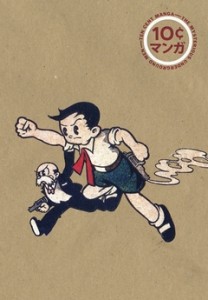By Osamu Tezuka. Released in Japan initially by Fujishobo; this edition was licensed from Tezuka Pro. Released in North America by PictureBox.
(Note: I spoil the ending in the review, be warned.)
I’m not sure that this manga, one of the first ones produced by the legendary Tezuka, can quite match the surreal heights of Picturebox’s first release, The Last of the Mohicans. It’s just as influential, but its style is more generic and the author’s early flaws show through a bit more. I think this actually works best as sort of a scholarly or critical edition, with the helpful essays by Ryan Holmberg providing a context that gives depth to what feels first time around like a pulpish adventure story. It will likely fare very well with rereads.
The entire plot feels like an old Republic serial, and the accompanying essay does mention Flash Gordon as one of Tezuka’s big influences. The main thing you won’t see in a live-action adventure serial, though, is Mimio, the intelligent rabbit who is modified (in a quite disturbing sequence showing the horrors of science for science’s sake) into a humanoid rabbit with feelings and emotions, but in a world where that sort of creature is going to be a pariah. In a later work, this might be the bulk of the story’s premise, but here we also follow John, the young scientist who is trying to follow in the footsteps of his late father and build a tunnel through the Earth (because flying is dangerous), with the help of his rich uncle and the Snidely Whiplash-esque Ham Egg, who many Tezuka fans will know is the villain the moment they see him.
What made this manga so influential to other Japanese artists and writers, of course, was the ending. I’ll admit, I found it rather curt and over the top melodramatic, but killing off one of the main characters and ending on a depressing note was a big sea change in the world of manga right then. Indeed, Tezsuka would come back to this basic storyline both in the 60s and 70s, revising and expanding, something he was known to do with several works (see also Princess Knight). I found it rather sad, given that Mimio not only wasn’t on the cover but didn’t make the cast of characters page. His death is the tragic ending, yet the book’s very design designates him to the forgotten extra pile. (Though this may be to avoid pointing out his disguises later on.)
The one thing this does have in common with its earlier Picturebox neighbor is seeing how the artists worked Western influences into the artwork of the title. Again, Holmberg’s essay is vital here, as the first time through you may simply read the story and characterization and miss the designs. I’d mentioned Flash Gordon, but there’s a lot of Disney here as well, as you’d expect from Tezuka. I also spotted the Popeye faces right off the bat. What I wasn’t expecting was Chic Young’s Blondie to be such a huge influence. Not only is John’s house and several poses reminiscent of Dagwood Bumstead, but the physician who watches over Mimio’s end is none other than Mr. Dithers! I’m not sure you could get away with that these days.
I definitely enjoyed this book, but I enjoyed it more from an academic, historical standpoint. If you’re the sort that loves to look at panels so see which issue of Bucky Bug this corresponds to, or to find out how this title resonates in a larger historical context, than this is the book for you. Well-researched, in a nice small size, and a good example of how, even when his writing is somewhat unformed and amateurish, Tezuka can still fascinate.

